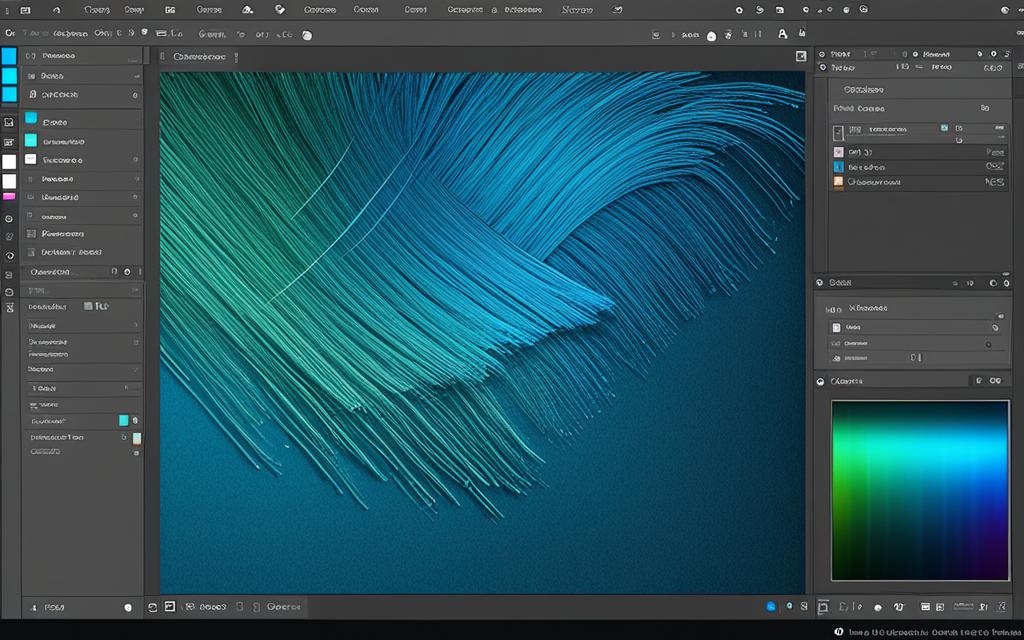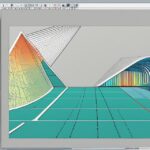Table of Contents
Are you a graphic designer looking to elevate your skills and take your designs to the next level? Look no further than the Adobe Creative Suite. With its powerful tools and versatile features, the Adobe Creative Suite is a must-have for any designer. In this article, we will explore essential tips and tricks that will help you master this software suite and unleash your creativity like never before.
Whether you are a beginner or a seasoned professional, the Adobe Creative Suite offers a world of possibilities. From Adobe Photoshop for image editing to Adobe Illustrator for creating stunning vector graphics, this suite has everything you need to bring your design ideas to life.
With the Adobe Creative Suite, you have the power to create visually appealing layouts, eye-catching illustrations, and professional-grade designs. But to truly make the most of this software, mastering the essentials is crucial.
In the upcoming sections, we will delve into keyboard shortcuts and workspaces customization, utilizing libraries and presets, non-destructive editing with layers and adjustment layers, harnessing the power of vector graphics, and leveraging smart object and type features. By understanding and applying these tips and tricks, you will be able to streamline your workflow, enhance your productivity, and create designs that truly stand out.
So, whether you are a design student, a freelance designer, or a part of a design team, join us on this journey to mastering the Adobe Creative Suite. Let’s unlock its full potential and take your design skills to new heights.
Keyboard Shortcuts and Workspaces Customization
One of the first steps to mastering the Adobe Creative Suite is familiarizing yourself with keyboard shortcuts. These shortcuts can significantly speed up your workflow and improve efficiency. Take the time to learn and memorize the most commonly used shortcuts for the specific Adobe applications you work with, such as Photoshop, Illustrator, and InDesign.
Customizing workspaces is another essential aspect of optimizing your productivity. Adobe applications offer the flexibility to customize your workspace layout according to your preferences and working style. By arranging tools, panels, and windows in a way that suits you best, you can create a workspace that enhances your efficiency and streamlines your design process.
To further enhance your productivity, consider creating custom keyboard shortcuts for specific actions or frequently used commands. This allows you to access tools and functions more quickly, saving you time and effort. Whether it’s selecting, editing, or applying effects, utilizing keyboard shortcuts can greatly improve your efficiency when working with Adobe applications.
Common Keyboard Shortcuts for Adobe Applications:
| Application | Shortcut | Description |
|---|---|---|
| Photoshop | Ctrl/Cmd + N | Create a new document |
| Illustrator | Ctrl/Cmd + C | Copy selected objects |
| InDesign | Ctrl/Cmd + D | Place a file into the document |
By leveraging keyboard shortcuts and customizing your workspaces, you can maximize your efficiency and productivity when working with Adobe Creative Suite. These small adjustments can have a significant impact on your workflow, enabling you to create stunning designs with ease.
Utilizing Libraries and Presets
Libraries and presets are powerful features within the Adobe Creative Suite that can save you a significant amount of time and effort. Whether you are working on a complex project or need to maintain consistency in your designs, libraries and presets offer a convenient way to streamline your workflow and ensure design coherence.
What are Libraries?
Libraries in Adobe Creative Suite allow you to store and access frequently used assets across different applications. These assets can include colors, character styles, logos, graphics, and more. By creating and organizing libraries, you can easily access your assets with a few clicks, eliminating the need to recreate them from scratch for each project.
How do Libraries Benefit Designers?
- Efficiency: By using libraries, you can swiftly access commonly used elements, saving valuable time during the design process.
- Consistency: Libraries enable you to maintain a consistent style and branding throughout your designs by utilizing predefined assets.
- Collaboration: Sharing libraries with team members ensures everyone has access to the same set of assets, promoting cohesive collaboration.
In addition to the built-in libraries provided by Adobe, you can also create and customize your own libraries to suit your specific design needs. This allows you to tailor your libraries to your unique style and preferences.
Presets for Instant Design Enhancements
In conjunction with libraries, Adobe Creative Suite offers presets that can further expedite your design process. Presets are predefined settings, styles, and configurations that you can apply to your projects with a single click. They can enhance your designs instantly and provide a consistent and professional look and feel.
Examples of Adobe Presets
Here are some examples of the preset types you may find in Adobe Creative Suite:
| Application | Preset types |
|---|---|
| Photoshop | Brush presets, layer styles, gradient presets |
| Illustrator | Swatch libraries, graphic styles, symbol libraries |
| InDesign | Paragraph styles, object styles, table styles |
By utilizing libraries and presets, you can enhance your productivity, maintain consistency, and elevate the quality of your designs. Take advantage of these powerful features within the Adobe Creative Suite to unleash your creativity and streamline your design process.
Non-Destructive Editing with Layers and Adjustment Layers
Layers play a fundamental role in Adobe applications like Photoshop and Illustrator, allowing graphic designers to work with different elements of their designs independently. This feature makes it easier to edit and manipulate specific parts of the artwork without affecting the rest. With layers, you have greater control and flexibility in your designs, enabling a non-destructive editing workflow.
To fully harness the power of layers, it is essential to understand layer management, organization, and blending modes. By utilizing these features effectively, you can achieve seamless integration of various design elements and create stunning visuals.
Layer Management and Organization
Properly managing and organizing your layers is crucial for maintaining a structured workflow and easier collaboration. Here are some tips to enhance your layer management:
- Naming Layers: Always assign descriptive and meaningful names to your layers for easy identification and navigation.
- Layer Grouping: Group related layers together to keep your workspace tidy and simplify complex designs.
- Layer Locking: Utilize the lock option to protect important layers from accidental alterations.
- Layer Visibility: Toggle layer visibility on and off to focus on specific design elements.
Blending Modes
Blending modes in Adobe applications allow you to control how different layers interact with each other, resulting in unique visual effects. Experimenting with blending modes can add depth, texture, and harmony to your designs. Here are some commonly used blending modes:
| Blending Mode | Description |
|---|---|
| Normal | The default blending mode that maintains the original appearance of the layers. |
| Multiply | Darkens the underlying layers based on the pixel values of the active layer. |
| Screen | Lightens the underlying layers based on the pixel values of the active layer. |
| Overlay | Combines the effects of Multiply and Screen blending modes, enhancing contrast and saturation. |
| Soft Light | Adds a subtle lighting effect to the underlying layers. |
Adjustment Layers
Adjustment layers provide a powerful way to make non-destructive adjustments to your artwork. Instead of directly modifying the pixels on the active layer, you can apply adjustments that affect all underlying layers. This allows for greater flexibility and the ability to fine-tune your designs without permanently altering the original elements. Some commonly used adjustment layers:
“Adjustment layers are game-changers when it comes to non-destructive editing in Adobe applications. They provide a wealth of tools and controls to tweak and enhance your designs while preserving the integrity of the original artwork.”
- Hue/Saturation: Adjust the hue, saturation, and lightness of your artwork.
- Curves: Fine-tune the tonal range and contrast of the image.
- Levels: Modify the white, black, and gray points of the image for better tonal balance.
- Color Lookup: Apply predefined color adjustments to create different moods or effects.
By utilizing layers, blending modes, and adjustment layers, you can take full advantage of non-destructive editing in Adobe applications. This technique empowers graphic designers to explore different creative possibilities, experiment with various effects, and achieve stunning results while maintaining the integrity of the original artwork.
Harnessing the Power of Vector Graphics
Adobe Illustrator is renowned for its vector graphic capabilities, providing scalability and precision in design. By mastering the Pen tool and shape tools, you can create smooth, scalable, and editable vector artwork. Understanding anchor points, handles, and Bezier curves will enable you to craft intricate and precise designs. With vector graphics, resizing your designs becomes effortless, without compromising quality. This versatility allows you to create artwork suitable for various applications, such as logos, icons, and illustrations.
Take the time to explore Adobe Illustrator’s features and experiment with different techniques to elevate your design skills. The Pen tool, for instance, allows you to create custom shapes and paths with unparalleled precision. By manipulating anchor points and Bezier curves, you can achieve intricate and detailed designs, customizable to your exact specifications.
Working with vector graphics in Adobe Illustrator offers numerous benefits for designers. Not only does it provide greater flexibility and control over your designs, but it also ensures that your artwork remains sharp and clear, regardless of the output size. Whether you are creating a small icon or a large-scale illustration, vector graphics allow for seamless scaling without any loss of quality.
Additionally, vector graphics are ideal for creating precise and clean designs. The use of mathematical formulas to define shapes and lines results in crisp edges and smooth curves. This level of precision is particularly valuable when designing logos or other graphics that require accuracy and attention to detail.
When working with Adobe Illustrator, embrace the power of vector graphics to unleash your creativity and achieve stunning, professional-quality designs. The scalability, precision, and versatility of vector graphics make Adobe Illustrator an indispensable tool for graphic designers seeking to create impactful visuals.
Smart Object and Type Features
When it comes to maximizing your design workflow in Adobe Photoshop and Illustrator, the Smart Object and Type features are game-changers. These powerful tools allow you to enhance your designs and work more efficiently. Let’s explore how you can utilize these features to their full potential.
Smart Objects: Preserving Quality and Flexibility
Smart Objects in Photoshop and Illustrator are a handy way to embed linked or embedded files within your design. What sets Smart Objects apart is their ability to preserve the original quality of the embedded files, ensuring non-destructive editing.
Imagine you’re working on a complex composition or a product mockup. With Smart Objects, you can embed the necessary elements and maintain their original properties, such as sharpness, resolution, and color accuracy. This allows for seamless edits without compromising the overall design.
“Smart Objects offer a tremendous amount of flexibility when working with reusable elements or complex compositions. They maintain the integrity of the embedded files and provide a safety net for any future revisions.” – Adam Harris, Senior Graphic Designer
Whether you’re collaborating with other designers or working on large-scale projects, Smart Objects streamline the editing process. If changes need to be made to the embedded file, simply edit the source file, and the changes will be automatically updated in your design.
Type Features: Enhancing Typography
Typography plays a crucial role in design, and Adobe Photoshop and Illustrator offer a range of Type features to enhance your text elements.
In Photoshop, you can access a variety of text formatting options, such as character styles, alignment, leading, and tracking. These features give you precise control over the appearance of your text, allowing you to create visually appealing typography that aligns with your design vision.
In Illustrator, the Type features are even more robust. You can manipulate text using the powerful Type tool, which offers extensive control over individual characters, paragraphs, and text blocks. With options like vertical scaling, scaling strokes, and optical kerning, you can achieve stunning and precise typographic effects.
Don’t forget the power of OpenType fonts—the extensive range of stylistic alternatives, ligatures, and swashes can elevate your typography to new heights of creativity and professionalism.
Creative Integration: Combining Smart Objects and Type
The integration of Smart Objects and Type features opens up a world of possibilities for your design projects. You can create editable text effects by converting Type layers into Smart Objects, allowing you to apply non-destructive filters, styles, and transformations.
Furthermore, by combining Type and Smart Objects, you can create visually stunning compositions that seamlessly blend text and graphic elements. Experiment with layer styles, blending modes, and opacity settings to achieve unique and eye-catching designs.
Summary
In conclusion, Smart Objects and Type features in Adobe Photoshop and Illustrator provide invaluable tools for graphic designers. Smart Objects ensure non-destructive editing and preserve the original quality of embedded files, while Type features offer precise control over typography. By harnessing these features, you can enhance your design workflow, streamline collaboration, and unleash your creativity to create exceptional designs.
| Benefits | Smart Objects | Type Features |
|---|---|---|
| Non-destructive editing | ✅ | |
| Preserves original file quality | ✅ | |
| Flexibility in complex compositions | ✅ | |
| Efficient editing workflow | ✅ | |
| Precise control over typography | ✅ | |
| Enhanced text effects | ✅ |
Conclusion
Mastering the Adobe Creative Suite is an essential journey for graphic designers looking to elevate their design skills. By utilizing keyboard shortcuts, customizing workspaces, utilizing libraries and presets, working with layers and adjustment layers, harnessing the power of vector graphics, and learning smart object and type features, designers can unlock the full potential of their creativity.
The Adobe Creative Suite is a powerful toolkit that empowers graphic designers to bring their ideas to life and create impactful visuals. With these essential tips and tricks at their disposal, designers can enhance their productivity and efficiency, ultimately taking their design skills to new heights.
Embrace the possibilities offered by the Adobe Creative Suite to express your creativity and produce exceptional design work. Whether you are a beginner or a seasoned professional, continuously honing your design skills with the Adobe Creative Suite will enable you to create stunning visuals that captivate and inspire.
FAQ
What is the Adobe Creative Suite?
The Adobe Creative Suite is a comprehensive software package widely used by graphic designers to unleash their creativity and bring their design ideas to life.
How can mastering the Adobe Creative Suite enhance my design skills?
Mastering the essentials of the Adobe Creative Suite can greatly enhance your design skills and productivity, whether you are a beginner or a seasoned professional.
Why should I learn keyboard shortcuts for Adobe applications?
Learning and memorizing keyboard shortcuts for Adobe applications like Photoshop, Illustrator, and InDesign can significantly speed up your workflow and improve efficiency.
What are libraries and presets in the Adobe Creative Suite?
Libraries and presets are powerful features within the Adobe Creative Suite that allow you to store and access frequently used assets, such as colors, character styles, logos, and graphics, across different Adobe applications. They help maintain consistency and save time and effort.
How can working with layers benefit me in Adobe applications?
Working with layers in Adobe applications like Photoshop and Illustrator allows you to work with different elements of your design independently, making it easier to edit and manipulate specific parts without affecting the rest of the artwork. It provides greater control and flexibility.
Why should I work with vector graphics in Adobe Illustrator?
Working with vector graphics in Adobe Illustrator allows for scalability and precision in design. You can create smooth, scalable, and editable artwork by mastering the Pen tool and shape tools, which is ideal for logos, icons, and illustrations.
How can smart objects and type features benefit my design workflow?
Smart objects and type features in Adobe Photoshop and Illustrator allow for non-destructive editing and preserving the original quality of embedded files. They are particularly useful when working with complex compositions, mockups, and reusable elements, revolutionizing your design workflow.
Where can I find more tips and tricks for mastering the Adobe Creative Suite?
You can find more tips and tricks for mastering the Adobe Creative Suite by exploring online resources, tutorials, and communities dedicated to graphic design and Adobe software.
How can I unlock the full potential of the Adobe Creative Suite?
By utilizing keyboard shortcuts, customizing workspaces, utilizing libraries and presets, working with layers and adjustment layers, harnessing the power of vector graphics, and learning smart object and type features, you can unlock the full potential of the Adobe Creative Suite and elevate your graphic design work to new levels of excellence.













